 | |
| Geographical range | Eastern Tibetan Plateau |
|---|---|
| Period | Bronze Age |
| Dates | c. 3300 BC – 2000 BC |
| Type site | Karuo |
The Karuo culture (3300 to 2000 BC [1] ) was a Neolithic culture in Tibet. The culture cultivated foxtail millet.
 | |
| Geographical range | Eastern Tibetan Plateau |
|---|---|
| Period | Bronze Age |
| Dates | c. 3300 BC – 2000 BC |
| Type site | Karuo |
The Karuo culture (3300 to 2000 BC [1] ) was a Neolithic culture in Tibet. The culture cultivated foxtail millet.
The type site at Karuo was discovered in 1977 at Chamdo County, Chamdo Prefecture, Tibet and excavated from 1978 to 1979. Located at about 3,100 m (10,171 ft) above sea level, [2] the site covered an area of 10,000 m². Over 7,000 artifacts have been discovered at Karuo, including 1,060 stone artifacts, 1,284 pottery shards and 4,755 bone objects. It is one of only a few archaeological sites on the Tibetan Plateau dating back so far, and it is in good enough condition for the foundations of houses to still be found, along with roads, walls, and stone altars in addition to the individual artifacts. [3]
Appearance-wise, the pottery at Karuo shows many similarities with pottery found at Majiayao sites, primarily the later phases, Machang and Banshan; however, the Karuo pottery was made using different methods and appears to be merely imitative. [4] The tool assemblage at Karuo also shows similarities with those found at sites in western Sichuan. [4]
The remains of 34 houses were found at the site. During the earlier stages, the houses at Karuo were round and semi-subterranean. During the later stages, the houses at Karuo were rectangular and subterranean. The later houses were more solidly built and represents a shift to more permanent habitation at Karuo. [4]
Karuo is the site of the oldest permanent settlement in Tibet [2] and represents the earliest evidence for agriculture on the Tibetan Plateau. [4] Agriculturally, the people at Karuo relied primarily on foxtail millet, while some evidence for broomcorn millet was also discovered. The oldest evidence for foxtail millet at Karuo dates to around 3000 BC. [2] The people of Karuo also supplemented their diet with hunting. [4]
The residents of Karuo suddenly abandoned the settlement around 1750 BC. [4] This is likely due to a change in climate, as Karuo likely required optimal conditions (higher temperatures) for foxtail millet to be grown successfully; Karuo coincided with a period of warmer temperatures in the region, and a return to cooler temperatures likely made foxtail millet cultivation at the site untenable. Broomcorn millet requires even higher temperatures for cultivation, so the broomcorn millet found at Karuo must have been obtained from trade with lower elevation sites. [4]

Millets are a highly varied group of small-seeded grasses, widely grown around the world as cereal crops or grains for fodder and human food. Most species generally referred to as millets belong to the tribe Paniceae, but some millets also belong to various other taxa.
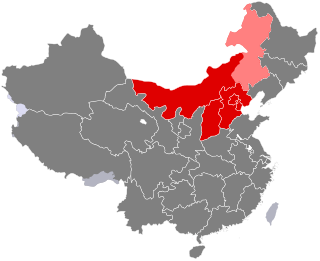
North China, or Huabei is a geographical region of China, consisting of the provinces of Beijing, Tianjin, Hebei, Shanxi and Inner Mongolia. Part of the larger region of Northern China (Beifang), it lies north of the Qinling–Huaihe Line, with its heartland in the North China Plain.

Kham is one of the three traditional Tibetan regions, the others being Amdo in the northeast, and Ü-Tsang in central Tibet. The original residents of Kham are called Khampas, and were governed locally by chieftains and monasteries. Kham presently covers a land area distributed between five regions in China, most of it in Tibet Autonomous Region and Sichuan, with smaller portions located within Qinghai, Gansu and Yunnan provinces.

The Yangshao culture was a Neolithic culture that existed extensively along the middle reaches of the Yellow River in China from around 5000 BC to 3000 BC. The culture is named after the Yangshao site, the first excavated site of this culture, which was discovered in 1921 in Yangshao town, Mianchi County, Sanmenxia, western Henan Province by the Swedish geologist Johan Gunnar Andersson (1874–1960). The culture flourished mainly in the provinces of Henan, Shaanxi and Shanxi.

The Longshanculture, also sometimes referred to as the Black Pottery Culture, was a late Neolithic culture in the middle and lower Yellow River valley areas of northern China from about 3000 to 1900 BC. The first archaeological find of this culture took place at the Chengziya Archaeological Site in 1928, with the first excavations in 1930 and 1931. The culture is named after the nearby modern town of Longshan in Zhangqiu, Shandong. The culture was noted for its highly polished black pottery. The population expanded dramatically during the 3rd millennium BC, with many settlements having rammed earth walls. It decreased in most areas around 2000 BC until the central area evolved into the Bronze Age Erlitou culture. The Longshan culture has been linked to the early Sinitic . According to the area and cultural type, the Longshan culture can be divided into two types: Shandong Longshan and Henan Longshan. Among them, Shandong Longshan Cultural Site includes Chengziya Site; Henan Longshan Cultural Site includes Dengfeng Wangchenggang Site in Wangwan, Taosi Site and Mengzhuang Site in Hougang.

Foxtail millet, scientific name Setaria italica, is an annual grass grown for human food. It is the second-most widely planted species of millet, and the most grown millet species in Asia. The oldest evidence of foxtail millet cultivation was found along the ancient course of the Yellow River in Cishan, China, carbon dated to be from around 8,000 years before present. Foxtail millet has also been grown in India since antiquity.
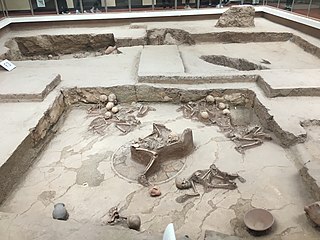
Lajia is a Bronze Age archaeological site in the upper reaches of the Yellow River, on the border between the Chinese provinces of Gansu and Qinghai. As at other sites of the Qijia culture, the people of Lajia had an agricultural economy based primarily on millet cultivation and sheep herding. They also kept pigs for use in ritual activities, including making oracle bones, and experimented with a high temperature-fired pottery described as proto-porcelain. The world's oldest known noodles were discovered at the site in 2005.
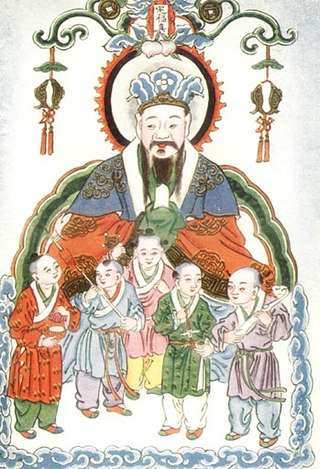
The Five Grains or Cereals are a grouping of five farmed crops that were all important in ancient China. Sometimes the crops themselves were regarded as sacred; other times, their cultivation was regarded as a sacred boon from a mythological or supernatural source. More generally, wǔgǔ can be employed in Chinese as a synecdoche referring to all grains or staple crops of which the end produce is of a granular nature. The identity of the five grains has varied over time, with different authors identifying different grains or even categories of grains.

Yushu Tibetan Autonomous Prefecture, also transliterated as Yüxü or Yulshul, is an autonomous prefecture of Southwestern Qinghai Province, China. Largely inhabited by Tibetans, the prefecture has an area of 188,794 square kilometres (72,894 sq mi) and its seat is located in the town of Gyêgu in Yushu County, which is the place of the old Tibetan trade mart of Jyekundo. The official source of the Yellow River lies within the prefecture. Historically, the area belongs to the cultural realm of Kham in Eastern Tibet.
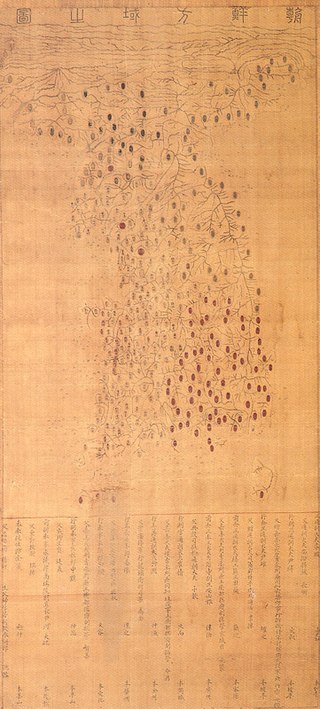
The Mumun pottery period is an archaeological era in Korean prehistory that dates to approximately 1500-300 BC. This period is named after the Korean name for undecorated or plain cooking and storage vessels that form a large part of the pottery assemblage over the entire length of the period, but especially 850-550 BC.
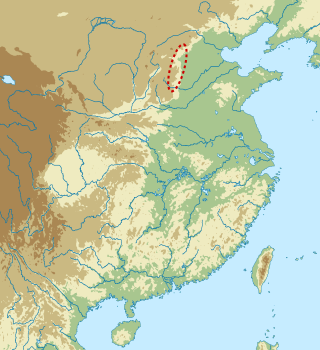
The Cishan culture was a Neolithic culture in northern China, on the eastern foothills of the Taihang Mountains. The Cishan culture was based on the farming of broomcorn millet, the cultivation of which on one site has been dated back 10,000 years. The people at Cishan also began to cultivate foxtail millet around 8700 years ago. However, these early dates have been questioned by some archaeologists due to sampling issues and lack of systematic surveying.
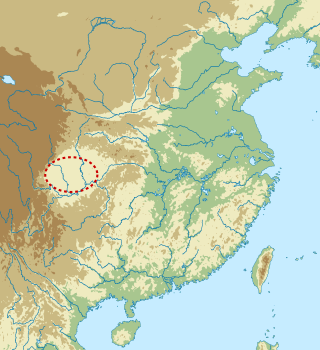
The Baodun culture was a Neolithic culture centered on the Chengdu Plain in Sichuan, China.

The Beixin culture was a Neolithic culture in Shandong, China. It was the successor of the Houli culture and precursor of the Dawenkou culture.

The Houli culture was a Neolithic culture in Shandong, China. The people of the culture lived in square, semi-subterranean houses. The most commonly found artefacts at Houli sites are pottery and stone tools. Jade artefacts and bone, antler, shell tools were also found at Houli sites. While the remains of domesticated dogs and pigs in the early stages of domestication were found at some sites associated with the culture, the people of the Houli culture relied mostly on hunting and fishing. The remains of rice, broomcorn millet, and foxtail millet were discovered at Houli sites.

The following outline is provided as an overview of and topical guide to Tibet:

The Jeulmun pottery period is an archaeological era in Korean prehistory broadly spanning the period of 8000–1500 BC. This period subsumes the Mesolithic and Neolithic cultural stages in Korea, lasting ca. 8000–3500 BC and 3500–1500 BC, respectively. Because of the early presence of pottery, the entire period has also been subsumed under a broad label of "Korean Neolithic".
Xishanping is an archaeological site in Gansu, China, located 15 km (9 mi) west of Tianshui. The site was occupied continuously from the Neolithic through the Bronze Age. The site is situated about 50 m (160 ft) above the riverbed on the southern bank of the Xi River, a tributary of the Wei River. The site was discovered by Pei Wenzhong in 1947.
Begash in an archaeological site in the Koksu River valley in historic Zhetysu, Kazazkstan. The site is situated in piedmont steppes above the Zhalgyzagash River, a tributary of the Koksu River. The people of Begash were transhumant pastoralists who mainly herded sheep and goats. They likely used the site primarily as a place of winter residence. The people of Begash buried their dead first in cist and later in kurgan burials. So far, the earliest direct evidence for domesticated grains in Central Asia can be found at Begash, with the earliest evidence for the presence of both domesticated free-threshing wheat and broomcorn millet.
Xinglonggou is a Neolithic through Bronze Age archaeological site complex consisting of three separate sites. The sites are located on a loess slope above the left bank of the Mangniu River north of the Qilaotu Mountains in Aohan Banner, Inner Mongolia, China. Xinglonggou is one of the most important sites of the early Neolithic Xinglongwa culture and provides evidence for the development of millet cultivation. The millet assemblage at Xinglonggou consists primarily of broomcorn millet. Xinglonggou is one of the few, early Neolithic sites in China for which systematic flotation has been performed.
Coordinates: 31°03′29″N97°12′32″E / 31.058°N 97.209°E